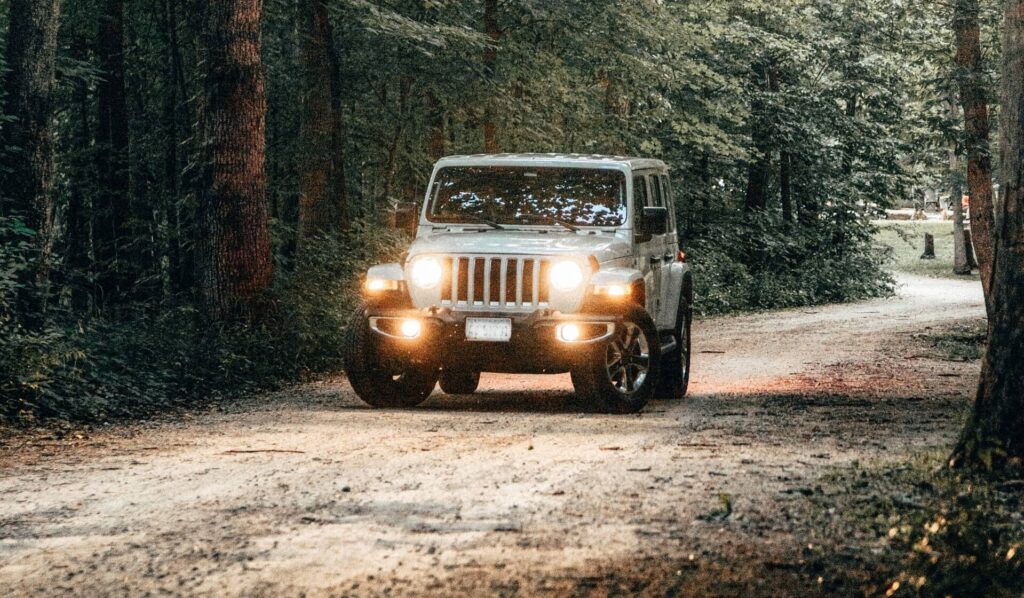The steering wheel on your Jeep Wrangler might be jerking when turning for many reasons, but the most common are:
- Damaged or improperly installed brake pads and/or rotors
- Bad U-Joints
- Bad Steering Stabilizer
- Drivetrain binding
Once you determine the root of the problem you can go ahead and fix it. Read on to learn how you can pin down each of these issues and how you can fix them. After that, it should be smooth driving.
Contents
Cause #1: Damaged or Improperly Installed Brake Pads/Rotors
If you have recently done work on your brakes this should be where you start. Go back and look at the work that was done and make sure everything was installed correctly.
Otherwise, look for signs of damage on your brake system, specifically worn brake pads and rotors.
Brake pads that need to be replaced tend to squeal, so if your Wrangler is making some noise on those turns that is a key indicator of what is wrong. You may also hear a clicking noise when braking.
Your vehicle may take more time to stop, and braking may feel more like stepping on a sponge than a pedal. The pedal may shake, or your car may favor one side when braking.
As for rotors, they will start to shake the wheel as they go bad. Look for signs of rust on the rotors, as well as any grooves. You should be able to run a finger across them to feel for any unevenness.
How to Fix
To fix this problem you just go through and change the brake pads and rotors as you would routinely. Take extra care to make sure they are installed correctly so you do not need to repeat the entire process.
Cause #2: Bad U-Joints
The easiest way to check the U-joints on your Jeep Wrangler is to get it up on a lift or at least jack up the front. The point is to take the load off the front wheels because these are the ones that will tie into your steering wheel problem.
Once you can get under the vehicle, check out both of the front axle U-joints. They should not be loose, but you do not want them to be too tight either. Check for shaking and wobbles.
Remove the wheel and look closer, inspecting all the rubbers. Everything should be intact and without wear. Look for other symptoms like rust water or leaking grease.
All of the spring-clamp fittings should be in the proper place, and you should not see any grease draining out.
How to Fix
If your vehicle has any of the problems listed above you need to replace your U-joints.
Remove the wheels, then unbolt the axle from the calipers. Once this is done you can also remove the calipers and rotor.
Having a friend can help remove the axle nut, but you will need to find a way to stop the axle from rotating to do this. Once you can get the axle nut and hub off you can remove the entire axle shaft.
You can try to get the U-joint out on your own, but using a U-joint press tends to be more effective. After this, you replace the part and then reverse the process to put everything back together.
Cause #3: Bad Steering Stabilizer
The steering stabilizer works with other parts (shock absorber, dampener, steering arm, and steering box) to absorb shock and vibration from the drive, keeping the surface of the road from rattling your steering wheel.
The easiest way to determine whether your steering stabilizer has gone bad is to look for any oil leaks in the area. You can usually find it directly attached to the tie rod with one end secured to the front axle.
How to Fix
You can delete the steering stabilizer as long as your other suspension components are in shape, but this is not always the best idea.
The most common way to fix the issue is to replace or upgrade the steering stabilizer. Installing is pretty straightforward, but it involves disassembling the axle in the same way you would to get to the U-joint.
Remove or replace the steering stabilizer, and your problem should be solved.
Cause #4: Drivetrain Binding
Drivetrain binding usually happens when you use your 4 wheel drive system on high traction areas frequently. While full-time 4WD or AWD systems can handle this fine but tends to wind up your transmission with a part-time system.
Other symptoms include:
- Wheel hopping
- Steering stiffness
- Difficulty shifting gears
You can also diagnose this by getting your Wrangler up on a lift, putting it in 2WD, and pushing the gas. The front axle should not move at the same speed as the rear axle, and you should be able to stop the front with your hand.
Alternatively, engage 4WD and ensure that the front and rear wheels are in sync.
How to Fix
You first need to turn the 4 wheel drive off in your wrangler and try to move to unlock the system. Reverse in a circle or drive on a loose surface to help the wheels turn at different speeds and unbind.
If you wait too long to address the issue you risk damage to your entire driveline, and this becomes a much bigger issue to address.
With that being said we came to the end of this guide. If you think this guide may be helpful for some one else, you can share this with them. You just have to hit one of the share buttons below.
Peace!

